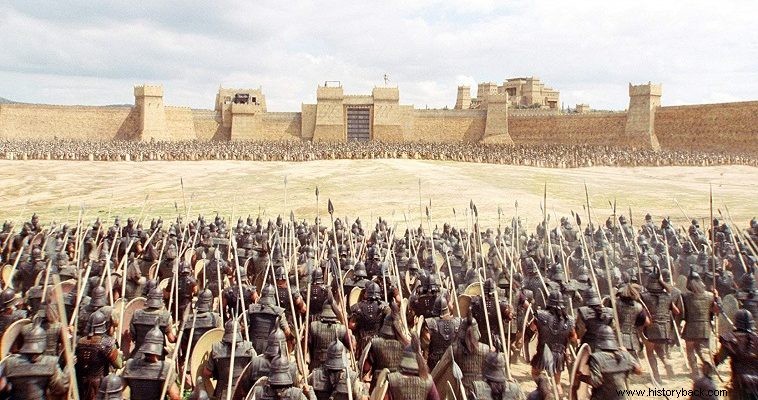
According to the Homeric description, Achilles with his famous Myrmidons did not participate in the first two battles that the Iliad presents with the occasion of a woman. However, like the legend of Helen's abduction, this view could be symbolic. The Myrmidons, as elite as they were, are very likely to have simply formed the general reserve of the Achaean army. In another view the Myrmidons did not take part in the first two battles because they may simply have been operating elsewhere. After the first battles the Trojans confined the Achaeans to their camp
The Trojans were encamped on the plain. Agamemnon sent an embassy to Achilles asking for reinforcements. But he refused or was simply unable to help. It is, however, rather strange to consider the participation in the battle of a detachment of only 2,500 men of decisive importance. At this point, there is definitely something more hidden than what it seems. What the Achaeans lacked was Achilles' strategic skills, which were amply demonstrated in the fourth battle, and not his few men.
In the battle that followed, the Trojans gradually prevailed and began to set fire to their warships. At that critical moment, Patroclus appeared, bearing the weapons of Achilles, and at the head of the Myrmids, he marched and overthrew the disorganized Trojans. The Trojans, taken by surprise by this unexpected development, retreated almost to the walls of their city, where they regrouped.
The intervention of the Myrmidons temporarily saved the Achaeans. However, the anarchic pursuit of the Trojans to the walls of Ilium resulted in the cutting off of a part of the Myrmidons from the other friendly forces and the murder of Patroklos. However, from a passage in the Iliad, it is clear that the entire force of the Myrmidons did not take part in the battle. Achilleas says:"... but I send my partner with many Myrmidons to fight", (mtf K. Doukas). The coming of night brought relief to the Achaean camp. Achilles convened a council of war, also assuming the chief strategy for the upcoming fourth and final battle of the Iliad.
Hector also this time followed his classic, as successful as it was until then, defense plan on a narrow front. So he arranged his army in the location between the hill of the new Ilium and the left bank of the Scamandros river. Opposite them stood the Achaeans, arrayed according to the shouts of Achilles. "Now stand not far from the Trojans, O divine Achaeans, but stand man to man and fight man to man. It is difficult for me, even if I am brave, to chase so many people and to fight them all...I will penetrate the lines from end to end, and I don't think any of the Trojans will be happy, whoever comes near my engho (spear)", he said to them ( 9Y 355-357 and 363-364 mtf K. Doukas).
Achilles' battle plan was simple in conception and would prove brilliant in execution. The aim of the first Achaeans was not to exert pressure on the entire length of the enemy front, but to break it up at a pre-selected point. Achilles did not intend to wear down his army with pointless attacks. He would concentrate his forces against the enemy center and simply occupy the opposing horns. Should they succeed in breaking the enemy front, the left Trojan horn would be trapped between Scamander and the Xantho River and the Achaean forces and would be destroyed.
The next day the two armies were again facing each other and the plain shone with the brilliance of their weapons. The Trojans maintained a defensive posture and awaited the attack of their opponents. And the Achaeans did not let them down. Led by the formidable Achilles, the Achaean phalanxes charged into battle. The focus of the impact was the Trojan center. The Trojans, unaccustomed to the new tactics, fought bravely, but did not manage to hold their front. After a fierce fight their center was broken and the men who made up the right horn, led by Hector, fled towards the city, while the unfortunates of the left horn were trapped between the Achaean spears and the rivers and exterminated or surrendered.
To emphasize exactly the magnitude of the disaster, the great Homer mentions the episode with the deified river Scamander, which tried to drown Achilles because it had filled its banks with corpses! The passage in the Iliad is characteristic where Achilles is seen throwing his spear and with only the sword in hand to defeat the Trojans. Such images of carnage are common in the chase phase, when the outcome has already been decided and the vanquished puts a "knife in the mouth" of the victor. And indeed the battle at this point had essentially ended with the victory of the Achaeans. Achilles then killed Hector in a fair duel. It was the height of his triumph.
